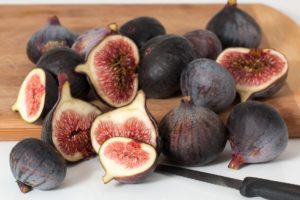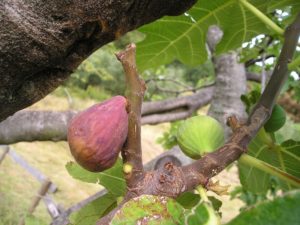Figs are one of the oldest fruits in the world and still a mainstay in home gardens today. These fruits are known for their sweet taste, which pair well with strong cheeses like goat cheese and blue cheese. They’re also commonly served with prosciutto or cooked into a jam to pair with crackers or toast. Figs can be eaten straight from the tree or preserved for a variety of delicious recipes.

Gardeners love to plant fig trees because of their beautiful leaves, which provide shade on a hot summer day. Fig trees thrive in warmer climates, sheltered from wind. They love full sun and cool soil, although they can grow in a wide range of soil types.
Figs will grow best in regions that have long summers and more mild winters, but they can also grow in colder climates with some extra attention.
General attributes of fig trees
The most common type of fig trees are Ficus carica, which are the popular fig variety chosen by home gardeners. Figs can range in color from purple, to white, green or yellow and their flesh can be gold or a dark red color. Fig trees can grow up to 33 feet tall, with leaves about 10 inches long and 7 inches wide. Figs are indigenous to western Asia and the Middle East.
Health benefits of figs
Figs are antioxidant rich, providing a rich source of vitamins A, B, C, and K. They also contain potassium, calcium, magnesium, iron and copper and are high in natural sugars. Many people use figs as a natural laxative, improving the amount of bowel movements. Another way figs are beneficial to your health is they can reduce the effect of free radicals.
Common fig tree diseases
 Like any plant, fig trees are prone to diseases. Factors like location and weather will impact which diseases have the potential to impact your fig tree, but it’s important to identify the disease so that proper precautions can be made to treat it. Below are common fig tree diseases:
Like any plant, fig trees are prone to diseases. Factors like location and weather will impact which diseases have the potential to impact your fig tree, but it’s important to identify the disease so that proper precautions can be made to treat it. Below are common fig tree diseases:
- Anthracnose
- Fig Rust
- Leaf Blight
- Fig Mosaic
- Endosepsis
- Pink Blight
- Aspergillosis
- Phomopsis Canker
- Fruit Souring
Planting fig trees
Best practices for planting fig trees are to plant in early spring or early fall in full sunlight. Fig trees should be planted about 25 feet apart to accommodate how large they can get when full grown. They can grow one foot a year and reach up to over 30ft high. It’s important to keep in mind when planting fig trees to give them a spot sheltered by heavy winds.
Pruning fig trees
Fig trees don’t require an overabundance of pruning, just some light maintenance to keep growth momentum going. Simply remove dead or diseased branches in the winter, which is their dormant season, to promote new growth. Remove any branches growing off the main branches as well to prevent them from growing too close to the trunk of the tree. Once your fig tree is established, trimming away half of the tree will ensure the strongest roots.
Harvesting fig trees
Harvest fig trees when they’re ripe, which means soft to the touch when squeezed, small cracks in the skin, drooping and a change in color. It will be obvious when tasting the fruit to tell if it’s ripe. Unripened figs have an unpleasant taste, while ripe figs are sweet and delicious. Once determined that your figs are ripe, don’t waste any time harvesting. Figs can be eaten directly from the tree, used within three days or stored for later use. If stored correctly, figs can be frozen for several years.
Caring for fig trees
Fig trees require frequent watering until they become established. Once established, they will need much less watering. To retain moisture around the root system of the fig tree and prevent weeds, add a layer of mulch. Fertilize once in the spring and again in the summer with a slow-release fertilizer. Once the tree has formed, little to no fertilization is required. If your fig tree is in a container, more fertilization is needed.
much less watering. To retain moisture around the root system of the fig tree and prevent weeds, add a layer of mulch. Fertilize once in the spring and again in the summer with a slow-release fertilizer. Once the tree has formed, little to no fertilization is required. If your fig tree is in a container, more fertilization is needed.
Conclusion
Don’t get discouraged if your fig tree does not produce fruit for quite some time. Fig trees do not product fruit their first year and can take a minimum of two years to bear fruit. In some cases, fruit will not show up for six years. In general, it will take 3-5 years for a fig tree to establish itself and produce a considerable yield.
We think every garden should have a fig tree! With the right research and some patience, you’ll be eating sweet figs straight from your very own backyard in no time.
Find & compare the world’s best garden suppliers for vegetable seeds or flower seeds to use in your garden. Garden Savvy is the gardening catalog of catalogs. Search our gardening database now!
Recent Posts
- Smart Gardening: How Technology Is Revolutionizing Horticulture
- Understanding Gardening Zones: What You Need to Know
- The Right Tools For Your Gardening And Landscaping Needs
- Maximizing Your Harvest: Square Foot Gardening Chart for Beginners
- Holiday Garden Scents: Plants for Natural Aromatherapy in Your Home






